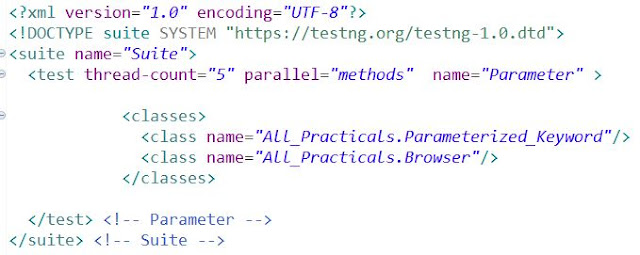We are now going to learn more advance stuff about the TestNG in this tutorials.
In first tutorial of TestNG (Introduction of TestNG), you get enough knowledge how to install, configure and different annotations.
Default Project Folder Structure With TestNG Library
Let's see the difference on JAVA class and TestNG class.
Below is difference in Option when you try to run the Java Class and TestNG Class.
TestNG Class: Similar to Java class but dont contains Main Method and contains different annotations to run as testng class.
Java Class Run
TestNG Class Run
How TestNG Change the Reporting in Selenium: Main Benefits of TestNG
Without TestNG: In Selenium without TestNG we have to add required PRINT LINE statements to verify that we are on right track or not or we need to print same information back and forth to excel or other files.
Without TestNG - When we run the Selenium Script, we can see output in Console.
With TestNG - We can see the complete format of how many test case run, pass, failed and skipped.
Also one separate folder 'test-output' get generated every time we run TestNG class and it has different kind of reports.
~~~~ Other TestNG Related Tutorial Links~~~~
TestNG Tutorial - Introduction Part
TestNG Tutorial Advanced Topics - Part 1 (Configuration of TestNG)
TestNG Tutorial Advanced Topics - Part 2 (TestNG.XML File)
TestNG Tutorial Advanced Topics - Part 3 (Priority, Groups, Parallel Mode, invocationCount, ThreadPool)
TestNG Tutorial Advanced Topics - Part 4 (Parameterization, Data Provider)
TestNG Tutorial Advanced Topics - Part 5 (Exclude,Listeners,DependsOnMethod)
In first tutorial of TestNG (Introduction of TestNG), you get enough knowledge how to install, configure and different annotations.
Default Project Folder Structure With TestNG Library
Let's see the difference on JAVA class and TestNG class.
Below is difference in Option when you try to run the Java Class and TestNG Class.
TestNG Class: Similar to Java class but dont contains Main Method and contains different annotations to run as testng class.
Note: We never use Main Method in TestNG Class.
Java Class Run
TestNG Class Run
How TestNG Change the Reporting in Selenium: Main Benefits of TestNG
Without TestNG: In Selenium without TestNG we have to add required PRINT LINE statements to verify that we are on right track or not or we need to print same information back and forth to excel or other files.
Without TestNG - When we run the Selenium Script, we can see output in Console.
With TestNG - We can see the complete format of how many test case run, pass, failed and skipped.
Also one separate folder 'test-output' get generated every time we run TestNG class and it has different kind of reports.
Mostly used format is 'Index.html' which display below structure in browser.
~~~~ Other TestNG Related Tutorial Links~~~~
TestNG Tutorial - Introduction Part
TestNG Tutorial Advanced Topics - Part 1 (Configuration of TestNG)
TestNG Tutorial Advanced Topics - Part 2 (TestNG.XML File)
TestNG Tutorial Advanced Topics - Part 3 (Priority, Groups, Parallel Mode, invocationCount, ThreadPool)
TestNG Tutorial Advanced Topics - Part 4 (Parameterization, Data Provider)
TestNG Tutorial Advanced Topics - Part 5 (Exclude,Listeners,DependsOnMethod)






















